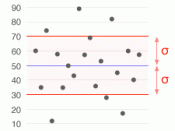There were two main driving issues behind our analysis of this Sport Obermeyer case: the measurement and understanding of demand from uncertain and disparate forecasts, and the allocation of production between factories in Hong Kong and Mainland China (Lo Village, Guangdong). The main challenges facing the company were long lead times, little to no feedback from the market before the first production decision (the first real demand signal is at the Las Vegas trade show in March) and inaccurate forecasts along with the lost profits that can result.
The first part of our analysis involved deriving an order policy from the forecasts provided in the sample problem. We solved this problem using simplifying assumptions and then relaxing some of those assumptions. Our initial assumption was that there was no minimum order quantity. We decided that risk would be minimized by producing the smallest allowable amount during the first production run due to the lack of information.
Thus, we calibrated our order quantity formulas to sum to 10,000 units.
We wanted to use a formula that took into account the average forecast as well as the standard deviation - in other words, we wanted to account for both the expected demand and the uncertainty. We began with the formula Q = Average Forecast - 2* Standard Deviation of the forecasts, since twice the standard deviation was said to approximate the standard deviation of the actual sales. Since this number did not sum to 10,000, we multiplied the standard deviation by a scaling factor, k, and solved for order quantity 10,000 units across all designs. We found k = 1.0607, which gives a quantity of 10,000 with no minimum order quantity.
Next, we had to modify this order policy because designs Stephanie, Isis, and Teri had initial orders below the minimum order...


